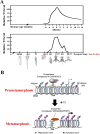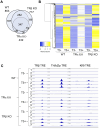Thyroid hormone receptor subtype-specific function in controlling organ-specific developmental timing and rate during Xenopus development
- PMID: 40551888
- PMCID: PMC12183033
- DOI: 10.3389/fendo.2025.1614439
Thyroid hormone receptor subtype-specific function in controlling organ-specific developmental timing and rate during Xenopus development
Abstract
Thyroid hormone (T3) is essential for vertebrate development as animals fail to develop into adults in the absence of T3. T3 is particularly critical for postembryonic development. This is a period around birth in mammals when most organs mature as plasma T3 level peaks. Unlike embryogenesis, postembryonic development has not been well-studied in mammals due to the difficulty to manipulate mammalian embryos and neonates. In contrast, anuran metamorphosis involves drastic transformations of essentially every organ/tissue of a tadpole and can be easily manipulated externally without maternal influence. In addition, most changes during metamorphosis resemble organ-maturation during postembryonic mammalian development. Thus, metamorphosis offers a unique and highly advantageous opportunity for studying postembryonic vertebrate development. Studies on the metamorphosis of Xenopus laevis and Xenopus tropicalis, two highly related species have offered significant insights on the function of thyroid hormone receptors in development. Here we will review some of these studies, with particular emphasis on recent genetic and genome-wide molecular analyses in the diploid species Xenopus tropicalis, that support a dual function model of TR, involving distinct, organ-specific roles of TRα and TRβ, the only known TR genes in all vertebrates.
Keywords: Xenopus laevis; Xenopus tropicalis; chromatin remodeling; developmental timing; metamorphosis; thyroid hormone receptor; transcriptional regulation.
Copyright © 2025 Tanizaki and Shi.
Conflict of interest statement
The authors declare that the research was conducted in the absence of any commercial or financial relationships that could be construed as a potential conflict of interest.
Figures




Similar articles
-
Organ-specific effects on target binding due to knockout of thyroid hormone receptor α during Xenopus metamorphosis.Dev Growth Differ. 2023 Jan;65(1):23-28. doi: 10.1111/dgd.12825. Epub 2022 Dec 1. Dev Growth Differ. 2023. PMID: 36397722 Free PMC article.
-
Thyroid hormone directly activates mitochondrial fission process 1 (Mtfp1) gene transcription during adult intestinal stem cell development and proliferation in Xenopus tropicalis.Gen Comp Endocrinol. 2020 Dec 1;299:113590. doi: 10.1016/j.ygcen.2020.113590. Epub 2020 Aug 20. Gen Comp Endocrinol. 2020. PMID: 32827515 Free PMC article.
-
Organ-Specific Requirements for Thyroid Hormone Receptor Ensure Temporal Coordination of Tissue-Specific Transformations and Completion of Xenopus Metamorphosis.Thyroid. 2020 Feb;30(2):300-313. doi: 10.1089/thy.2019.0366. Epub 2020 Jan 23. Thyroid. 2020. PMID: 31854240 Free PMC article.
-
Essential and subtype-dependent function of thyroid hormone receptors during Xenopus metamorphosis.Vitam Horm. 2023;123:503-523. doi: 10.1016/bs.vh.2023.02.004. Epub 2023 Mar 25. Vitam Horm. 2023. PMID: 37717996 Free PMC article. Review.
-
Life Without Thyroid Hormone Receptor.Endocrinology. 2021 Apr 1;162(4):bqab028. doi: 10.1210/endocr/bqab028. Endocrinology. 2021. PMID: 33558878 Free PMC article. Review.
References
-
- Gilbert LI, Frieden E. Metamorphosis: A problem in developmental biology. In: , 2nd ed. Plenum Press, New York: (1981).
-
- Gilbert LI, Tata JR, Atkinson BG. Metamorphosis: Post-embryonic reprogramming of gene expression in amphibian and insect cells. New York: Academic Press; (1996).
-
- Shi Y-B. Amphibian Metamorphosis: From morphology to molecular biology. New York: John Wiley & Sons, Inc. (1999).
-
- Leloup J, Buscaglia M. La triiodothyronine: hormone de la métamorphose des amphibiens. C.R. Acad Sci. (1977) 284:2261–3.
Publication types
MeSH terms
Substances
LinkOut - more resources
Full Text Sources

